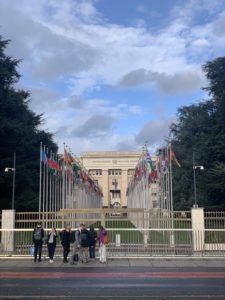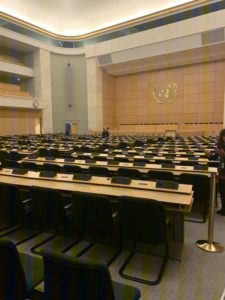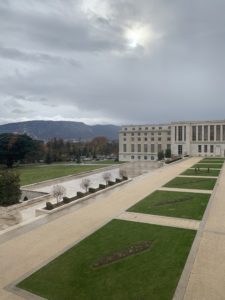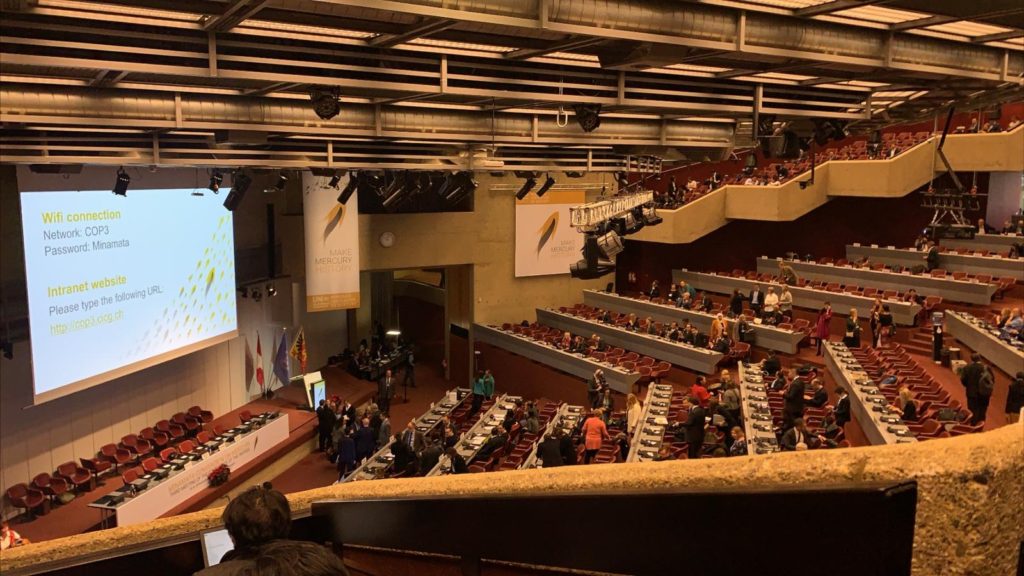On Thursday, November 28th, we visited the United Nations Office at Geneva (UNOG). Located at the Palais des Nations, it is the second largest after the United Nations Headquarters in New York. The building was constructed in the late 1930’s to be remodeled in the late 1960’s.

During our visit, there were ongoing meetings at UNOG. The amount of people caused an initial delay to our planned tour. From the beginning, the regulation of the entrance and the security processes were extensive. After checking our passport, they finally gave us access to the buildings. We had the opportunity to participate in a guided tour. Before we started, they gave us the fundamental instructions that we should follow for the rest of the tour. These instructions included not taking pictures during ongoing meetings, staying close to the tour guide and not taking photos or videos from the tour guide.

The first place we visited was one of 34 meeting rooms at UNOG where a negotiation were taking place. From a balcony, we could see that the meeting room prepared for 200 people was only half full. Compared to the number of people in the Minamata Convention, this negotiation was much smaller; Despite its difference in delegates, the same protocol followed in the Minamata Convention was followed in this meeting. This protocol consists in ordering the parties in alphabetical order, having the 6 official UN translations available and the right for each party to bring their own translator. Unlike the Minamata Convention, observers took the space of the last rows and not the balconies. It was we, the visitors, who took the balconies as part of the tour.

As the tour continued, the tour guide explained the importance of international relations in the world and how even before the United Nations, the League of Nations had an important duty to make this possible. In addition to the first meeting room, we had the opportunity to see other meeting rooms in the different buildings such as the Council Chamber located in Building C. Walking through the hallways, we had a great view of Parc de l’Ariana, the 46 hectare park previously owned by Gustave Revilliod. After his death, he left the park to the City of Geneva. The City of Geneva made the park available to the United Nations and for its offices and today, UNOG stands at the heart of the park.
As we walked, delegated stepped out of meeting rooms while others stepped into meetings. It was without a doubt a busy day at UNOG and a busy day overall United Nations meetings in Geneva. The last meeting room we visited was the new Human Rights and Alliance of Civilizations Chamber (Room XX) . It is one of the largest conference rooms in the Palace of Nations. This room contained a work of art in the ceiling donated by Spain. Unfortunately, there was an ongoing meeting that day so we couldn’t take photos of the meeting room.
At the end of the tour, the tour guide recommends that we take the free guide on how to practice the Millennium Development Goals (MDG) in our daily lives. This little guide will be very useful for our lives because it gives us advice on how to contribute to the MDG in simple and accessible ways
In the afternoon, we returned to the Minamata Convention. Due to new modifications to the convention schedule, we attended the meeting, Contact Group: Effectiveness. This session focused on the Draft decision MC-3 Arrangements for the first effectiveness evaluation of the Minamata Convention on Mercury. This session was marked by the continuous participation of the EU and US. Both had very contrasting opinions on the adoption of the indicators. The US was in disagreements with other parties such as Iran and the EU who suggested on trialing the indicators and later review them. The US did not wish to commit to the indicators because they were “exercising some fundamental errors” and, they did not have enough time to review them completely. The EU on its side, continued to offer technical and financial assistance to parties in need. The EU role is very similar to that of the simulation; very collaborative and understanding. It was interesting to see how other parties were willing to be flexible on the indicators and reformulate the indicators’ wording. Unfortunately there was no agreement at the end and this text had to be deferred for the next COP.
